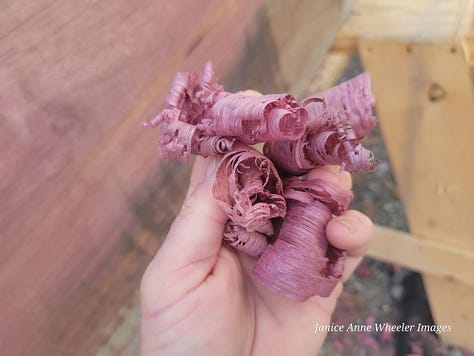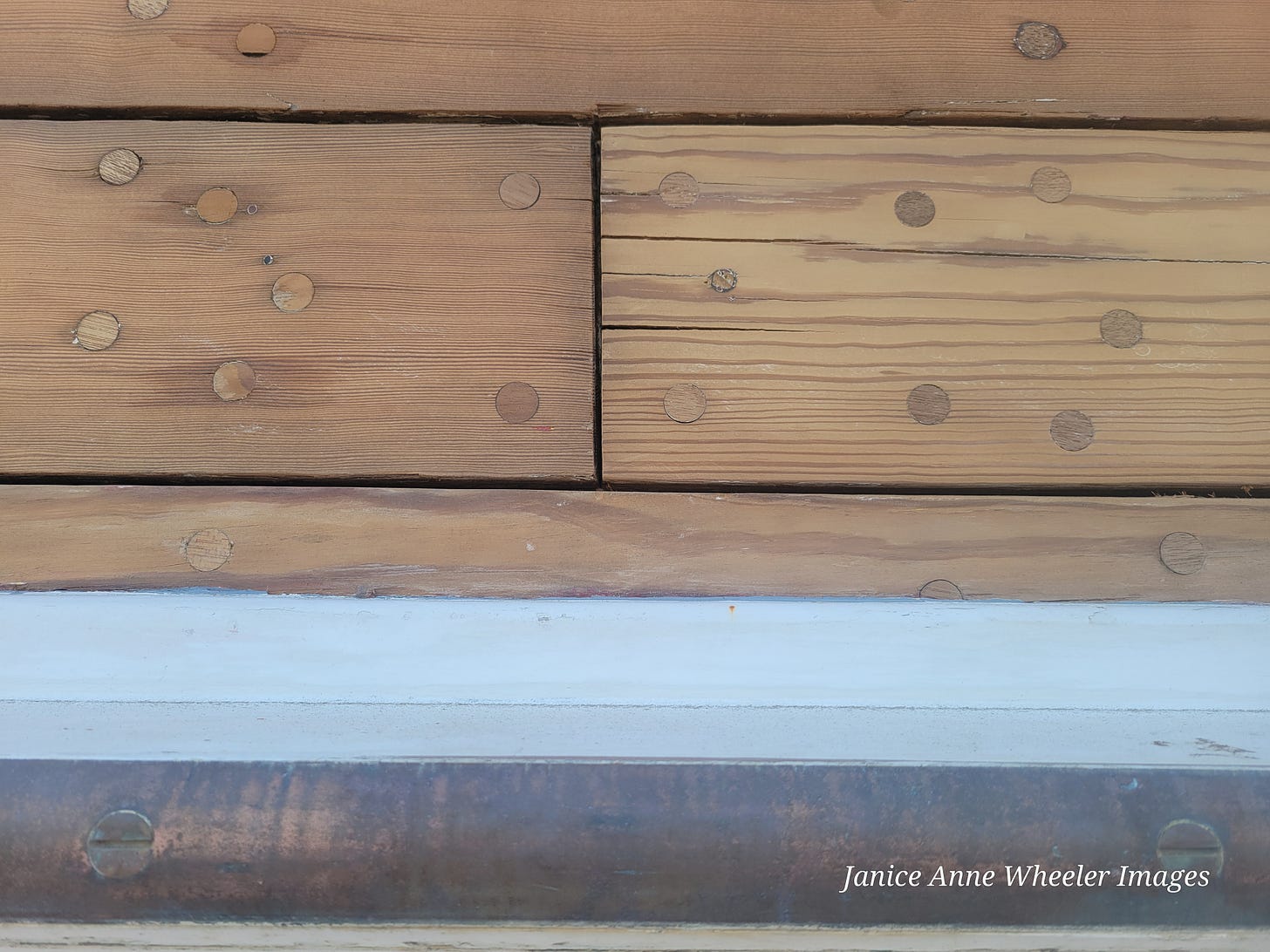Our first commodity has arrived and is resting quietly, enshrouded in newly purchased canvas, protected, draped carefully and evenly on all sides, to avoid damage from exposure to the elements. Rock solid yet fragile, it will soon be essential in its new environment.
Purpleheart Tree, scientific name Peltogyne, has many variations. This miracle of Mother Nature goes by a plethora of other monikers: Amaranth, Violetwood, Purperhart, Pau Roxo, Pau ferro and the indigenous namesakes, Guarabu, Morado, Tananeo. There are no Purpleheart trees currently on endangered lists and many countries, including Panama and Costa Rica, regulate the harvest to assist in its viability.



I’m sure this commodity was essential in its old environment, too, near the equator, on another continent, albeit bordering the same mighty ocean. We estimate that this lumber came from an impressive tree at least four feet in diameter and research deduces a height of 130-150 feet with a brilliant, green, protective canopy and thousands of shiny, paired leaves, each turning carbon dioxide back into oxygen for the earth’s unsustainable population. The color and size vary within its vast range from southern Mexico to southeastern Brazil. The main attraction of this beautiful wood is the length of its armless trunk, which can be as much as seventy feet; the single board we purchased was 6” x 18” x 27’. Purpleheart is revered for natural rot and insect resistance as well as strength and hardness, perfect for projects such as ours. The blooms are coveted by bees and beekeepers. Secondarily, its stunning color is used for watch faces, furniture, trinkets and household items.
Although it may seem rare and exotic due to its striking appearance, wood-database.com tells us that it is a durable, long-lasting, stable and sustainable wood species. We are all aware of the centuries-old conflict; man trying his best to survive and earn a living, while preserving resources and forests for both future generations and the innumerable organisms that dwell in them.
To me? This is a truly PRECIOUS COMMODITY. That stack of lumber will save my home. I’ve called myself a ‘Conservative Tree-Hugger’ for decades and claim complete independence from political parties (I simply vote for the best candidate…). Mother Nature’s environment is one of my most pertinent concerns, as my immersion and reliance is deeper than most. I’ve never before chosen to utilize something as potentially controversial as Rainforest hardwood, and I hope there are positive economic effects within one of the poorest nations in South America.
This tree was harvested, we hope responsibly, in Suriname and imported directly by Gannon & Benjamin Marine Railway in Vineyard Haven, Massachusetts, USA, located on iconic Martha’s Vineyard. I was admittedly surprised at the location of our resource and told our resourceful Boatbuilder (previously employed there) exactly that. Self-described on their website as “a small, flourishing, boatyard whose mission and passion is designing building, repairing, maintaining and sailing wooden boats,” it seemed the perfect place to obtain our wooden boat’s new components.
The 1350-pound slabs of eggplant-purple lumber will hold STEADFAST together and get her to another ninety years. Her stem (the very front piece of any vessel) and her knee (which attaches the stem to the keel, or bottom) were originally built of American White Oak and, while we found rot, it was due to ingress of water and not the quality or choice of the product itself. The most common phrase on this project? “It lasted ninety years. It doesn’t owe anyone anything.” And frankly, most of both of the pieces being replaced are still darn solid. These are the originals.


Our second commodity is, perhaps, even more interesting if less exotic and colorful. STEADFAST was built by Brooklyn, New York’s Wheeler Shipyard in 1934; the exterior planking was Old-Growth Long Leaf Yellow Pine, which, according to The North Carolina Division of Parks & Recreation (here) www.ncparks.gov covered millions of acres of the southeastern United States. All harvestable trees experienced that demise by 1930 with the exception of a few in their state parks, one of which is claimed to be a remarkable 473 years old. I was exquisitely curious as to how they would know that about a living tree, but was not able to discern their method of determining such a tremendous and exact age. Does anyone know?
Regardless, we all realize that the natural resources of North America were ransacked upon ‘discovery’, particularly during the Industrial Revolution as it was such a period of massive construction. Prior to that, the British Crown exported many prime products to build warships, which the Colonies then fought against during the Revolution and beyond. The Long Leaf Yellow, also known as Heart or Loblolly Pine, was so strong and plentiful that it was used for everything from factories and railroad ties to boatbuilding. It, like Purpleheart, is naturally rot and insect resistant, allowing many of the beams from textile mills in the south as well as industrial buildings nationwide to be reclaimed. After many dead ends and one strikingly expensive option we were able to track down a true gentleman in Pennsylvania (and were sworn to secrecy) who is currently compiling the 600 board feet required to recreate STEADFAST’s bow with plank materials specified in the 1930’s. Our decision to not use original materials in the knee and stem was influenced by the fact that there aren’t pieces of oak as large as we wanted. You know why; that commodity, too, was overharvested.
Much of the lumber that you see today is Yellow Pine; it grows fast enough to farm and is so resilient that it has become a remarkably renewable resource when well-managed by landowners and lumber companies. The new growth is completely different than the centuries-old giants which fell before any of us were born. The difference between modern lumber and original old-growth is distinctive; note the very tight grain on the left vs a typical new growth plank.

Is this interesting to you, my readers? I don’t want to lose any of you and hesitated to write a story about lumber until I built this particular paragraph in my mind, standing on the elevated deck of STEADFAST, watching the reflecting pink sunset silhouette a church spire. Here’s the thing. One more thing.
This information about trees is perhaps not relevant to more than a few of you. But what we as curious, present, and forward-thinking individuals, understand and should keep in mind, on a daily basis, is how much we don’t know. And to me, nearly everything is interesting. “Who knew?” The inquisitive, the explorers, the travelers of the world are humbled, I think, when we realize how much we still have to learn, see, and perhaps experience, not everyone wants or is able to wander the planet.
Many of my favorite Substack comments come from readers who are intrigued or even intimidated by my experiences. Living on the water is understandably not appealing to most. I know we’re a little crazy. Many have had admirable instances of their own and now prefer to read from the comfort of their recliner. I hope, from the bottom of my writer’s soul, that I do an appropriate job transporting people to the rough North Atlantic or a quiet Bahamian beach. That is the writer’s goal, after all, isn’t it? To place the reader precisely where you are describing. No simple task, and I take it very seriously.
Reading can take you places that you have never been or never really wanted to go. It can teach you many things. In this modern age the same thing goes for audio and video, although I’m of the generation that I still prefer to hold a book in my hands for the full, relaxing, transporting, immersion. While I say that, every day I experience all of you electronically and IT’S WORKING WONDERFULLY!
Thanks for being interesting. J
Here’s your weekly sunrise from the Eastern Shore of Maryland, or as I call it now, Merry-land. After all, we’re staying through Christmas….
SPARRING WITH MOTHER NATURE has taken a bit of a turn from jousting on the deep blue sea with white sand and palm strewn remote islands to an unexpected and long term refit/rebuild. Like all dynamics this world tosses us, we adjust. My work on Substack is the best part of my week. I share my unique world with people who buy in, respond, empathize and contemplate. Please share these stories with others who you think may enjoy them. My telling seems to resonate with a few people and that just brings us all closer to humans in a busy, complicated world. So, simply and importantly said, thank you.
To receive my stories in your in-box please subscribe here. ALL of my content is free and will always be. If you have the means to purchase your subscription, it’s certainly appreciated; $5 a month or $40 a year.
I am always interested in your insightful comments, stories and perceptions. Please keep doing that; it helps me know that I’m headed in the right direction.
Enjoy your SUNDAY MORNING READ? Hit the little heart key. In our algorithmic world, it helps move my stories around to new folks. I can’t explain it any better than that!







Thank you for sharing your thoughtful pursuit of the materials to rebuild STEADFAST's bow. Your beautifully written post today hit on something that I wish the top 1% of the world's consumers (most of us living a modern life, by the way) could somehow directly experience, and that is the relationship between the goods we consume, and the "invisible" human and other natural costs of that consumption.
A couple years ago I took a break from desk jockey work and apprenticed as a cabinetmaker. One of those days began with a trip to the lumberyard to purchase a special piece of rift sawn white oak for a project. I remember hoping the homeowners for whom this board would soon become part of their home might appreciate this functional thing of beauty and consider for a moment the decades to grow the mighty oak, the effort to fell its sturdy trunk, then process it into lumber for us to build into furniture. I asked myself, what would it be like if everything we touched could somehow tell the story of all the steps it took to get to us? Would we actually buy less stuff, or just rationalize the true costs of our consumption?
In other words, you want a cheeseburger? OK, then you should see how much water is used to grow alfalfa for feed, visit the CAFO where the animals lived, meet the workers in the slaughterhouse, spend a day with the folks in the trucking industry, etc. Do you still want the burger?
Dendrochronology is the science of determining the age of trees and shrubs. They sometimes use narrow, very long, hollow drill bits to remove samples of the growth rings. The can also determine the age of nearby fallen trees by correlating the width of growth rings with a living tree. Its all very interesting. When my son and i cut a dead tree for firewood, we always like to count the rings. A few years ago, we counted the rings on a Ponderosa pine stump we cut, and before we got to tiny rings in the center that were to tiny to count, we dated our tree to 1804, the year Lewis and Clark came through the area and also the year Haiti became independent.